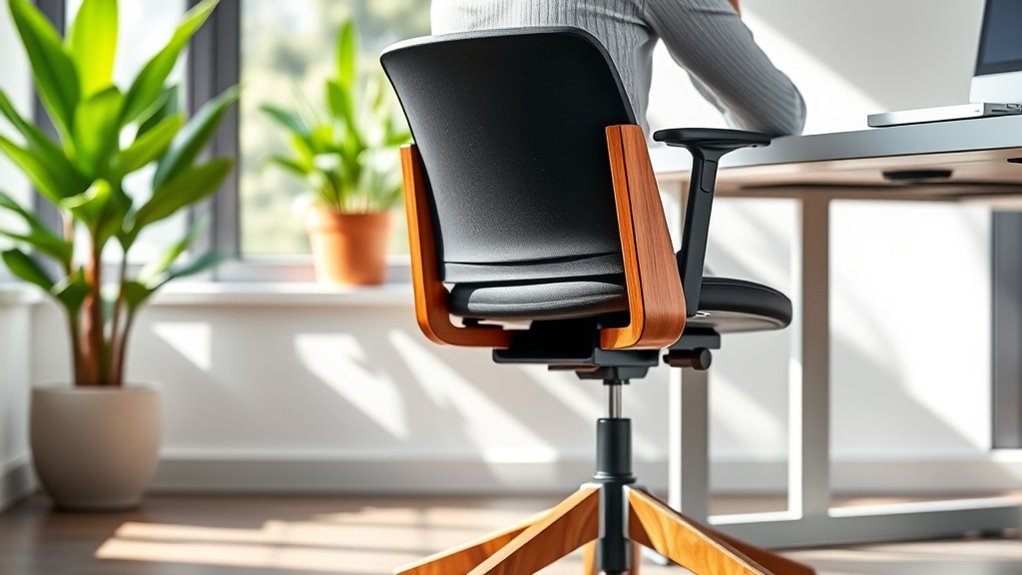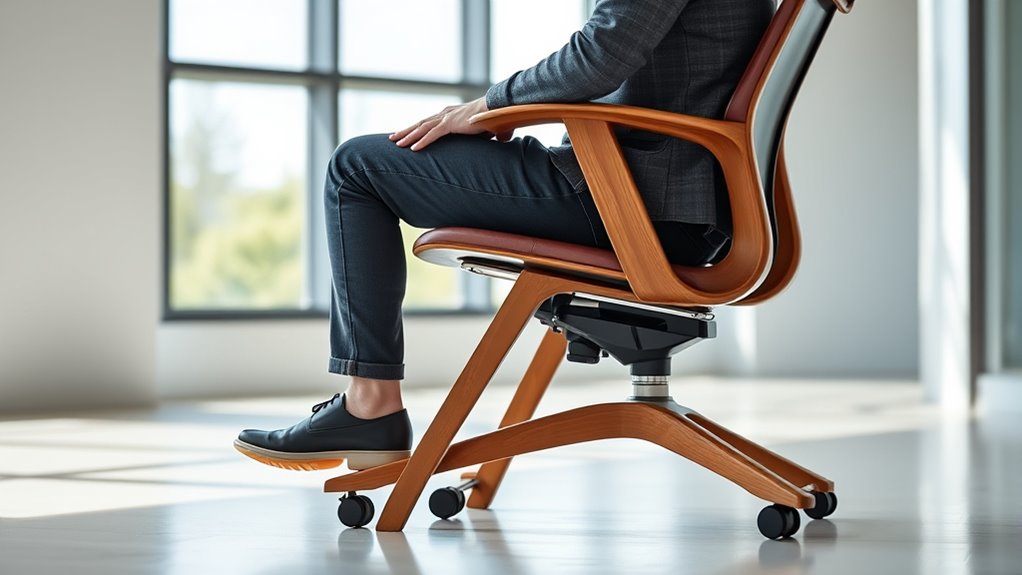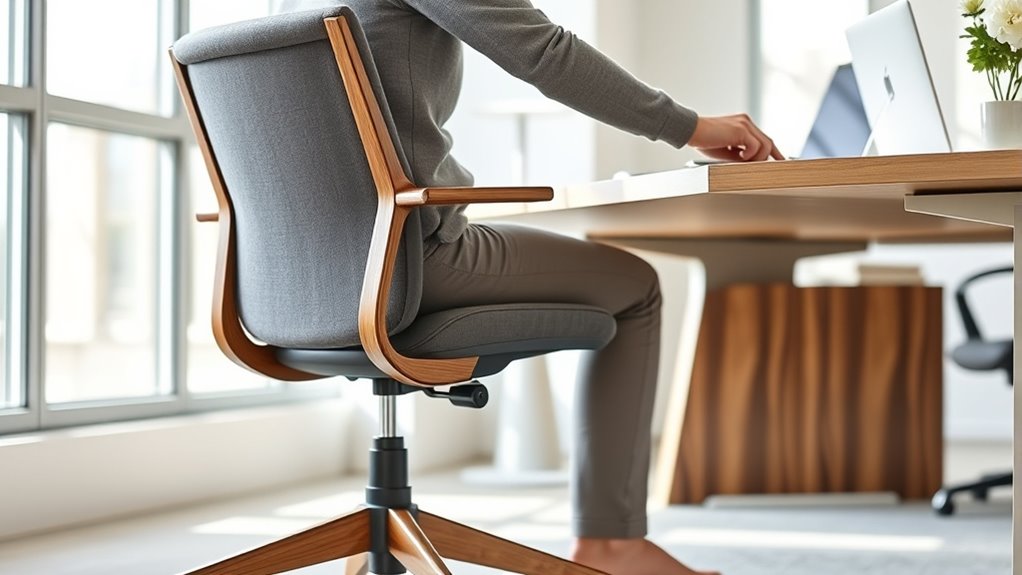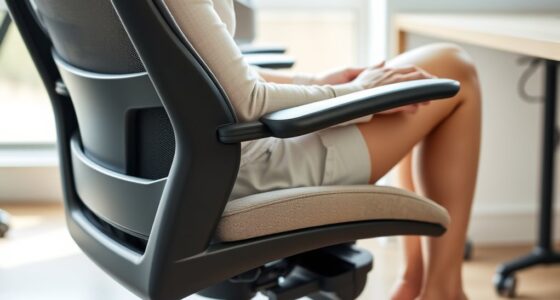Kneeling chairs can be worth it if you’re looking to improve your posture, reduce back pain, and stay active while working. They promote proper spinal alignment and evenly distribute your weight, which helps prevent slouching and discomfort. However, they may cause discomfort for some, especially with knees or ankles, and aren’t suited for everyone. To decide if they’re right for you, understanding the benefits and challenges is key—more details are just ahead.
Key Takeaways
- They promote better posture and spinal alignment, reducing back pain during long sitting periods.
- Extended use may cause discomfort or strain, especially for those with knee or ankle issues.
- Stylish and modern, they can enhance workspace aesthetics but may lack customization options.
- Proper adjustment and moderation are essential to prevent discomfort and maximize ergonomic benefits.
- Overall, they are worth considering for improved ergonomics but depend on individual needs and comfort.
Benefits of Using a Kneeling Chair

Have you ever wondered if a kneeling chair could improve your posture? One of the main ergonomic benefits is how it encourages proper spinal alignment. Unlike traditional chairs, kneeling chairs help distribute your weight more evenly between your hips and shins, reducing pressure on your lower back. This promotes better posture by keeping your spine in a more natural position. As you sit, you’ll likely notice less slouching and fewer aches in your shoulders and neck. The open angle created by a kneeling chair helps prevent slumping, which can lead to long-term musculoskeletal issues. Additionally, understanding the importance of contrast ratio can help you appreciate how visual clarity and image depth are vital in creating an effective home cinema setup. Overall, using a kneeling chair can make a noticeable difference in your comfort and posture, especially during long periods of desk work.
Common Disadvantages and Challenges

While kneeling chairs offer ergonomic benefits, they also present several disadvantages that can affect comfort and usability. First, ergonomic misconceptions may lead you to believe they’re suitable for long-term use, but extended sitting can cause discomfort or strain. Second, durability concerns arise because some models use fragile materials that wear out quickly, reducing their lifespan. Third, adjusting to the chair’s design can be challenging, especially if you experience knee or ankle discomfort. Fourth, some users find the chairs unattractive or unsuitable for shared spaces, limiting their versatility. Additionally, crochet styles for locs demonstrate how creative customization can enhance personal style, but such versatility is often limited in standard kneeling chair designs. Overall, while these chairs can improve posture, their disadvantages highlight the importance of considering fit, durability, and realistic expectations before making a purchase.
Who Should Consider a Kneeling Chair

If you spend long hours at a desk and are seeking to improve your posture, a kneeling chair might be a good fit. It offers ergonomic benefits by encouraging a more upright sitting position, reducing strain on your lower back and shoulders. If you’re someone who experiences discomfort with traditional chairs, a kneeling chair can help align your spine and promote better circulation. Additionally, its aesthetic appeal can add a modern, stylish touch to your workspace. However, it’s best suited for individuals who don’t have knee or joint issues, as prolonged kneeling can cause discomfort. If you value ergonomic support and want a chair that looks sleek and contemporary, a kneeling chair could be a worthwhile investment to enhance your productivity and comfort. Moreover, understanding the Kia Tuning options available can inspire you to customize your workspace with stylish accessories that match your ergonomic setup.
Tips for Proper Use and Adjustment

To get the most benefit from your kneeling chair, it’s important to adjust it properly to fit your body. Start with ergonomic adjustments to guarantee your hips are open and your knees are comfortably supported. Here are some posture tips:
- Set the height so your hips are slightly above your knees, promoting natural spinal alignment.
- Adjust the knee pad angle to keep your shins at a comfortable, gentle incline.
- Make sure your back is straight, and shoulders are relaxed for ideal ergonomic support.
- Regularly check and fine-tune your seat and knee pad positions to maintain proper posture during extended use.
- Incorporate proper support for spinal alignment to ensure long-term comfort and reduce strain during prolonged use.
Proper adjustments help reduce strain and maximize comfort, making your kneeling chair a healthier workspace.
Final Thoughts on Whether They’re Worth It

Are kneeling chairs truly worth the investment? If you prioritize ergonomic benefits, they can help improve your posture and reduce back pain, making them a valuable addition to your workspace. Their design encourages an open hip angle and promotes active sitting, which benefits your spinal health. Proper wood stove safety standards and regular maintenance can prevent fire hazards if you decide to have a wood stove nearby, ensuring a safe environment while working or relaxing. However, aesthetic appeal varies; some find kneeling chairs stylish and modern, while others prefer traditional office furniture. Consider how much you value ergonomic benefits versus comfort during long hours. If you’re willing to adapt to their unique posture and find a style that suits your space, they can be worth it. Ultimately, whether they’re worth it depends on your specific needs, preferences, and willingness to incorporate them into your daily routine.
Frequently Asked Questions
How Long Should I Use a Kneeling Chair Daily?
You should use a kneeling chair for about 30 minutes to an hour daily to maximize ergonomic benefits and improve your posture. Start with shorter sessions, gradually increasing as your body adjusts. This helps prevent strain and promotes proper spinal alignment. Remember, it is crucial to listen to your body, take breaks, and combine kneeling chair use with regular movement to achieve the best posture improvement over time.
Can Kneeling Chairs Help With Existing Back Pain?
Kneeling chairs can help with existing back pain by promoting better posture and reducing pressure on your lower back. They encourage you to sit upright, improving posture improvement over time. Additionally, they offer circulatory benefits by alleviating thigh and leg pressure. While they may provide relief and support, it is crucial to use them correctly and consult a healthcare professional if your pain persists.
Are Kneeling Chairs Suitable for Short or Tall Individuals?
Thinking about kneeling chairs? They can be a good fit if you’re tall or short, but it’s all about posture adjustment. Shorter folks might find the seat height suitable, while taller users need adjustable options for proper seating comfort. These chairs help align your spine, but make certain you choose one that matches your height for ideal posture support. It’s like finding the right shoe size — comfort begins with proper fit.
What Maintenance Is Required to Keep a Kneeling Chair in Good Condition?
To keep your kneeling chair in good condition, follow a simple cleaning routine by wiping down the frame and padding regularly with a damp cloth. Check and tighten adjustment tips to ensure it stays comfortable and secure. Avoid harsh chemicals that could damage the materials. Regular maintenance helps prolong its lifespan and keeps you comfortable, so make a habit of inspecting your chair and making adjustments as needed.
Do Kneeling Chairs Comply With Ergonomic Safety Standards?
Kneeling chairs often meet ergonomic certifications, ensuring they align with safety compliance standards. When you choose a reputable brand, you can trust that the chair has passed safety tests and adheres to ergonomic guidelines. This helps reduce strain and improve posture. Always check for certifications like BIFMA or ANSI to confirm safety compliance, so you can confidently use your kneeling chair knowing it supports your health and safety.
Conclusion
Ultimately, whether a kneeling chair is worth it depends on your unique needs. If you’re willing to invest time in proper use and adjustment, it might just be the best thing since sliced bread for your posture. But don’t forget, it’s not a one-size-fits-all solution. If you’re serious about improving your comfort and health, give it a shot—you might find it’s worth its weight in gold. Sometimes, you have to try before you buy.









